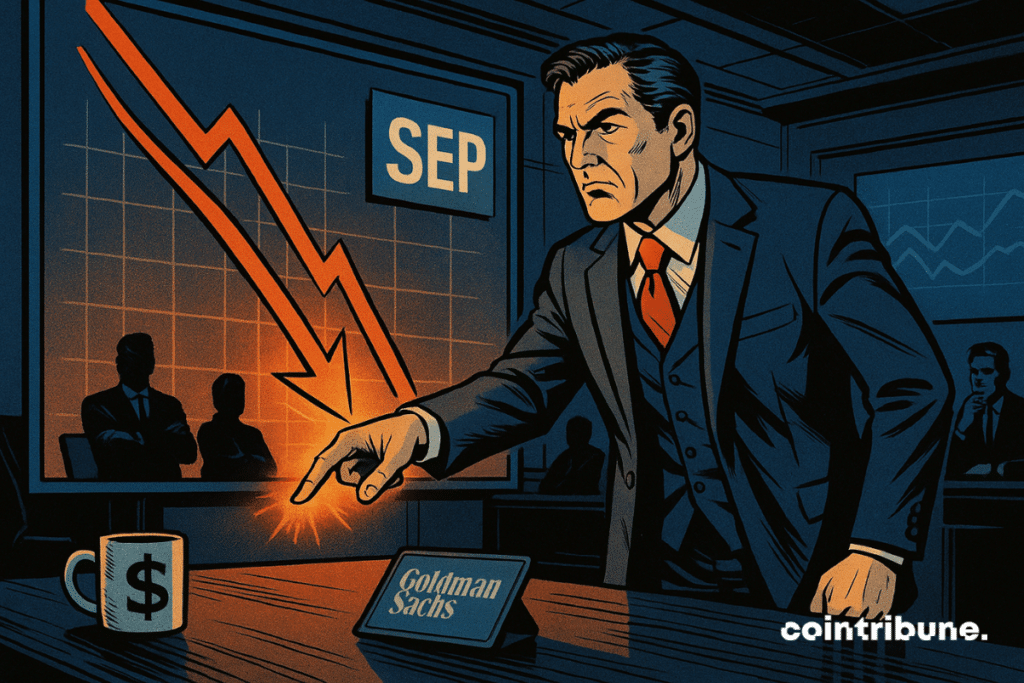Goldman & Citi Shock Markets: Triple Rate Cuts Coming Before 2026
Wall Street's biggest players just flipped the script.
The dovish bombshell: Goldman Sachs and Citigroup now project three Fed rate cuts by December—despite Powell's poker face. Traders are already front-running the pivot.
Behind the reversal: Cooling inflation meets softening labor data. Or maybe banks just need cheaper money to prop up their balance sheets (wink).
What it means for crypto: Risk assets just got a turbo boost. Bitcoin's likely licking its chops as liquidity floodgates prepare to open.
Funny how rate cuts always arrive *after* institutional positions are set. Convenient, no?

In brief
- The U.S. Federal Reserve could initiate a rate cut starting September 2025, according to several major banks.
- Goldman Sachs, Citigroup, and Wells Fargo anticipate three rate cuts totaling 75 basis points by the end of the year.
- A rate cut would favor investment in risky assets like cryptos by boosting liquidity and weakening the dollar.
- Conversely, JPMorgan and Morgan Stanley take a more cautious stance, citing a delayed timeline or no cut at all this year.
Goldman Sachs, Citigroup, and Wells Fargo bet on a rate cut starting in September
While the Fed resists TRUMP and holds rates, some major U.S. financial institutions, Goldman Sachs, Citigroup, and Wells Fargo, anticipate a first interest rate cut by the Federal Reserve as early as September.
They project a cycle of three successive cuts, totaling 75 basis points by the end of the year. This outlook relies on the need to address a slowdown in economic activity while stimulating private investment.
For these players, the time has come to adjust monetary policy to prevent an excessive weakening of growth. This scenario rekindles investors’ interest in risky assets, especially cryptos, which are traditionally sensitive to liquidity conditions.
These monetary easing expectations rely on several well-established economic mechanisms :
- Lower rates facilitate credit access, encouraging investment in speculative assets like bitcoin ;
- Rate cuts tend to weaken the dollar, thereby increasing the attractiveness of assets denominated in other currencies or uncorrelated with the traditional monetary system ;
- Monetary easing increases investor risk-taking, leading them to seek higher yields in non-traditional asset classes like cryptos ;
- Historically, rate cut cycles have often coincided with bullish phases in the crypto market, especially during periods of strong liquidity.
This dynamic, if it materializes, could mark a turning point after a long sequence of monetary tightening that weighed on the entire market. However, this optimistic reading is far from unanimous.
Increased caution at JPMorgan and Morgan Stanley
Unlike Goldman Sachs, JPMorgan and Morgan Stanley display a considerably more cautious stance regarding rate developments.
Indeed, JPMorgan forecasts a single 25 basis point cut, but only in December, three months after the first projections from its competitors. Morgan Stanley, for its part, does not anticipate any rate reductions this year due to continued uncertainty about the state of the economy and inflation risks.
This lack of consensus reveals the complexity of current macroeconomic analysis, as well as the difficulty in accurately predicting the Fed’s decision timetable.
Such divergent projections take place in a tense context, marked by the Fed’s decision to hold interest rates following its July meeting. The institution’s chairman, Jerome Powell, expressed concerns about slowing growth while not ruling out further tightening if economic conditions require it.
This mixed signal has helped slow momentum in the crypto market, already cooled by an uncertain global context. Added to this is the potential impact of Donald Trump’s trade policies, including a new wave of tariffs, which could weigh on the U.S. economy and lead the Fed to reconsider its priorities.
In this climate of uncertainty, the crypto market wavers. Bitcoin, for example, is currently in a consolidation phase around $114,000, a level reflecting investor wait-and-see sentiment. The prospect of a rate cut constitutes a potential bullish factor. If the Fed decided to hold or even raise rates, it could trigger a new correction phase in the market, already weakened by months of monetary tightening. Conversely, easing could open the way to a broad rebound.
Maximize your Cointribune experience with our "Read to Earn" program! For every article you read, earn points and access exclusive rewards. Sign up now and start earning benefits.

